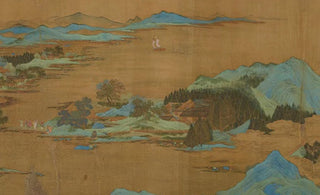
Traditional vs. Modern Oriental Color Palettes shade of change
The world of oriental aesthetics is a rich tapestry of colors, textures, and artistic expressions that have captivated the hearts and minds of enthusiasts for centuries. Oriental Aesthetics, a premier provider of systematic, high-quality professional services for oriental artists, collectors, and enthusiasts, is dedicated to showcasing the beauty and evolution of classical oriental art. In this article, we delve into the intriguing realm of traditional and modern oriental color palettes, exploring the shades of change that have shaped this vibrant aspect of artistic expression.
Traditional Oriental Color Palettes: The Essence of Heritage
Traditional oriental color palettes are an integral part of the cultural heritage and historical context of the East. Drawing inspiration from nature, philosophy, and symbolism, these palettes evoke a sense of harmony, balance, and tranquility. The colors used in traditional oriental art reflect the connection between the human spirit and the natural world. Earthy tones like deep browns, subtle grays, and warm ochres symbolize stability, grounding, and a profound respect for the earth. Vibrant reds, auspicious yellows, and regal golds represent prosperity, good fortune, and power. Serene blues and greens evoke a sense of tranquility, while delicate pinks and purples signify grace and femininity. Traditional oriental color palettes stand as a testament to the timeless beauty and cultural significance of classical oriental art. These hues capture the essence of Eastern aesthetics and embody the rich cultural heritage that continues to inspire generations.
Modern Oriental Color Palettes: A Contemporary Interpretation
As time progresses and artistic expressions evolve, modern oriental color palettes have emerged, offering a fresh and innovative perspective on oriental aesthetics. While still drawing inspiration from traditional roots, modern color palettes push the boundaries of creativity, embracing new influences and cultural exchanges. In modern oriental art, bold and vibrant colors are often used to convey energy, dynamism, and a sense of forward-thinking. Bright oranges, vivid blues, and striking yellows add a contemporary flair to traditional motifs, infusing them with a renewed vitality. The use of contrasting colors and unexpected combinations creates a visual impact that demands attention and invites exploration. Modern oriental color palettes represent a fusion of tradition and innovation, bridging the gap between the past and the present.
The Intersection of Tradition and Modernity
In the ever-evolving world of oriental aesthetics, the interplay between traditional and modern color palettes is a fascinating phenomenon. Many contemporary artists and designers draw inspiration from both realms, seamlessly blending the classic and the contemporary in their creations. This synthesis of tradition and modernity allows for the exploration of new possibilities while honoring the rich heritage of oriental art. By infusing traditional color palettes with modern touches or incorporating traditional elements into a modern color scheme, artists can create unique and captivating works that resonate with audiences across cultures and generations. The intersection of tradition and modernity in oriental color palettes represents a harmonious coexistence of the old and the new, embracing the spirit of innovation without sacrificing the essence of heritage.
Exploring the Emotional Impact
Color has the power to evoke emotions, set moods, and convey deeper meanings. In oriental art, the choice of color palette plays a crucial role in shaping the emotional impact of a piece. Traditional oriental color palettes, with their serene and harmonious hues, often elicit a sense of calmness, tranquility, and introspection. These palettes create a meditative atmosphere, inviting viewers to immerse themselves in the artwork and discover hidden layers of meaning. On the other hand, modern oriental color palettes, with their vibrant and dynamic shades, evoke a sense of excitement, energy, and contemporary sensibility. These palettes make a bold statement, commanding attention and sparking curiosity. The emotional impact of oriental color palettes, whether traditional or modern, adds depth and resonance to the artistic experience.
Conclusion: Embracing the Ever-Evolving Beauty
In the realm of oriental aesthetics, the interplay between traditional and modern color palettes showcases the dynamic nature of artistic expression. Traditional oriental color palettes, rooted in cultural heritage and symbolism, evoke a sense of harmony and tranquility, while modern palettes push boundaries and infuse contemporary energy. The intersection of tradition and modernity allows for endless possibilities, bridging the gap between the past and the present. Whether immersing oneself in the serenity of traditional hues or embracing the vibrancy of modern shades, both approaches offer unique emotional impacts and captivate audiences. Oriental Aesthetics, dedicated to preserving and promoting classical oriental art, invites you to explore the rich tapestry of traditional and modern oriental color palettes, celebrating the ever-evolving beauty that continues to inspire and captivate art lovers worldwide.
Company Profile
Oriental Aesthetics is a leading provider of professional services for oriental artists, collectors, and enthusiasts. With a deep appreciation for classical oriental art, our mission is to preserve, promote, and celebrate the beauty and cultural significance of oriental aesthetics. Through meticulous curation, expert guidance, and fostering a vibrant community, we offer comprehensive services that cater to the needs of artists and art lovers alike. Explore the enchanting world of oriental art with Oriental Aesthetics and experience the timeless allure of traditional and modern oriental color palettes.
























